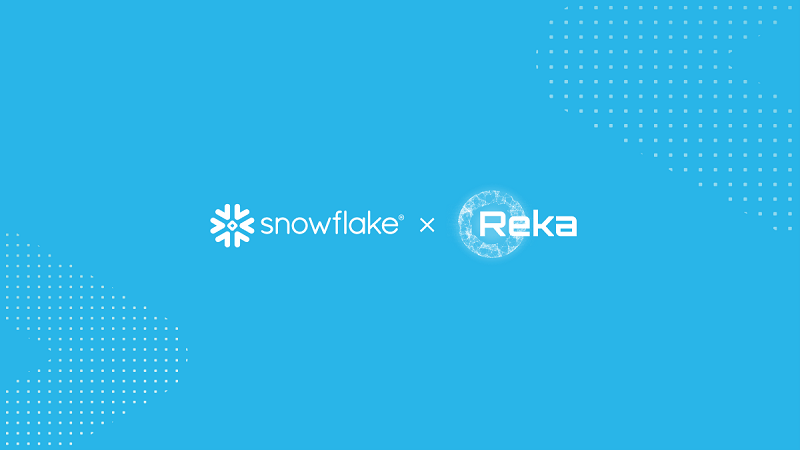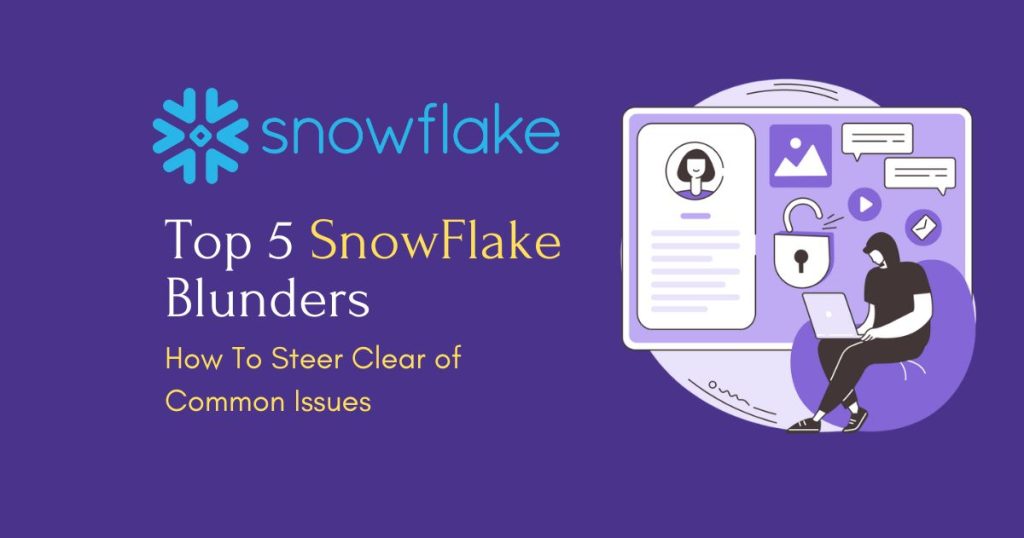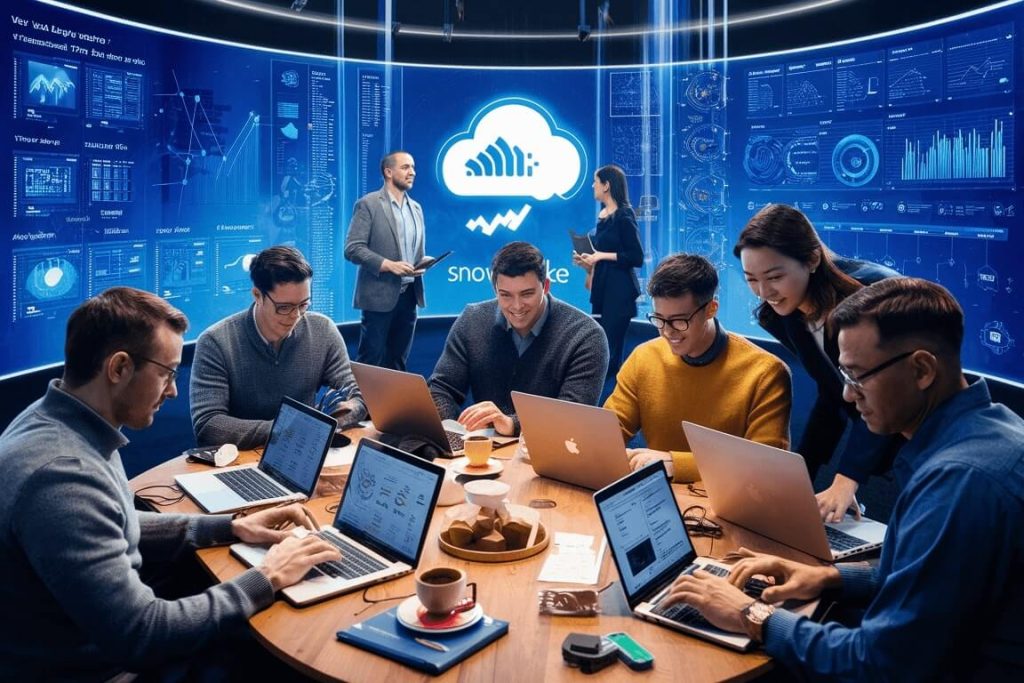Snowflake, a SaaS or cloud-computing service specializing in data warehousing, has gained remarkable adoption in several fields.
Modern organizations invest colossal amounts of money in data storage, processing, and analytics; thus, Snowflake’s breakthrough approach, incredible functionality, and popularity significantly impact the SSDA market. From a data engineer, analyst, or a business management and optimization perspective, Snowflake provides a strong foundation for data management and analytics.
The newly emerged concept of Snowflake data services proves to be highly critical in various industry sectors, particularly the areas that concern business intelligence and analytics. By making it easy to store, process, and analyze large datasets covering different aspects of organizations’ operations, Snowflake has availed the possibility of making decisions based on data within the contemporary fast-paced global economy.
Advanced AI and Data Governance:
First-Mover Advantage
These organizations are creating the base to leverage superior AI through Snowflake. They complement the best practices in AI with an emphasized focus on the management of data.
Data Trends Report 2024 Insights:
Data Foundation
The importance of a good database with current structure governance receives a lot of attention from organizations. We supercharge specific governance aspects in the Data Cloud and they will bolster our data usage by roughly 50%.
Customer Base
Snowflake works cooperatively with thousands of diverse organizations, both big and small, from emerging companies to industry titans. Some companies that have benefited from the Headspring services include Adobe, Capital One, Mastercard, PepsiCo, Siemens and others.
Usage Statistics
9,000+ Snowflake accounts gain great benefits of the snowflakes cloud data warehouse for creating reliable data infrastructures and investigating AI opportunities.
As of 2022 total customer count of Snowflake was 5944 and the average daily query rate was 1496 million plus. Companies that use Snowflake are comparatively more in the United States based on the statistics.
Innovation and Accessibility
LLM-Based Apps
Today, developers are making a wave of applications built based on legal informatics and data science known as LLM-based apps. Organizations engaged 34k developers who spent one year on 33k apps built on LLM in the Streamlit community.
More Facts About Data Sharing Capability of Snowflake
Snowflake for safe data sharing offers several ways to enable users to share data and engage with others at their workplaces. Let’s dive into the details:
Secure Data Sharing:
What Is SDS?
Secure Data Sharing enables users to share some specific objects within a defined database within the Snowflake user’s account with other Snowflake accounts.
There are several different objects that you share in Snowflake, including:
- Databases-( examples of tables, such as the dynamic table, the external table, and the Iceberg table)
- Secure views
- Secure materialised views
- Secure user-defined functions (UDFs)
How It Works:
There is no duplication or transfer of information in any way, shape or form from one account to another when the information is being ‘shared.
The sharing is built on Snowflake’s services layer and metadata.
- terminology, which provides the means for leveraging its services layer and accessing a metadata repository.
- It means that the shared data option does not use the storage of the consumer account and does not lead to substantial expenditures.
- Subscribers are only billed for the compute resources (or virtual twin data warehouses in this case) consumed in querying the shared data.
- It is also relatively easy to get set up on the part of the providers and the access to shared data is virtually instantaneous from the consumer’s perspective.
- To achieve a more detailed concept, it is possible to summarize the actions of providers and the general idea as follows:
- Customers accumulate the shared read-only databases and to control the access occurring using a basic role-based access control standard.
Types of Sharing:
- Listing: Provide one or more share and additional metadata as a data product with one or more of the accounts.
- Direct Share: Share a given table or an individual view or any other object directly with another account in the region.
- Data Exchange: Contribute towards the establishment of a set of accounts that are linked together and get to be given a share in such a group of accounts.
Network of Providers and Consumers:
In other words, they can both offer and require shared data as fast and as easily as possible In essence, any account on Snowflake edition is capable of offering, as well as demanding, shared data.
To sum up, it can be stated that with the help of Snowflake’s data-sharing features organizations and businesses can safely share data, gain access to it, and generate valuable insights based on this information.
Streams: The ins and outs of Change Data Capture (CDC)
The capabilities for loading data with changes into Snowflake can be useful when implemented using Streams. Okay, let’s compare it to a bookmark in a book—a stream is kind of like a bookmark except it points to a given moment in time within your data set. Here are the key concepts:
Offset Storage
When you create a stream, the stream forms take an initial checkpoint of every row in the source object for example a table or a view. This makes it possible to track changes from this snapshot which act as the offset for the versioning process. It tracks DML changes after these snapshots, or in other terms, it stores data as to how DML has been changing.
Change Records
Streams return changed data capture records that document the pre and post-state of a row. These records directly map to the column name of the source object and also contain standard metadata columns for each change event.
Table Versioning
Streams are associated with specific table versions. Another notable feature of the Committed Transaction API is the fact that every transaction causes the creation of a new table version. While streaming a data pool or even a relative area of a data pool, you get differences between a stream offset and the current version of the table.
Use Cases
They are useful to build intelligent data pipeline; you can move and load only the transformed data with the latest updates within the table into other tables. They carved out chunks of space and then filled them from one time to the next, like bookmarks that you can drop and make again.
Tasks
This is the case since automation provides the win for different reasons as will be discussed below.
Tasks are a feature that makes it easy to perform certain actions automatically due to the occurrence of certain events. Here’s what you need to know:
- Triggered Actions: Tasks run SQL statements or call procedures at runtime depending on corn or event (for example, when data gets updated in a stream).
- Scheduled Tasks: This can be initiated by setting up regular tasks for the time-consuming work of checking and updating objects, data loading, execution of other operations, etc.
- Event-Driven Tasks: In this instance, it is used to invoke tasks that are dependent on a particular situation (for example, data coming in a stream form).
- Dynamic Workflows: Integrate Streams and Tasks to construct agile data Employ effective processes that fit your firm’s requirements.
Cloning: Efficient Replication
Cloning in Snowflake is similar to making a copy of your data as if you took a snapshot and made one from it. Here’s what you should consider:
- Zero-Copy Cloning: Clones are lightweight—they function as a reference or link to an object’s storage until copies are made and divergent changes start being made. From this, we can conclude that there is no data movement involved in Shake’s environment.
- DDL and DML Considerations: Cloning continues the schema and data, Although cloning carries the schema and data it retains some awareness from DDL or DML transaction on the source object.
- Time Travel: Consequently, clones also end up having the exact time travel abilities as the source. You can even perform a search from a certain time point.
- Data Retention: Clones carry all data in parallel to the object from which they were cloned for the same amount of time.
In summary, Snowflake’s advanced features empower you to work with real-time data, automate tasks, and efficiently replicate your data. Whether you’re a data engineer, analyst, or scientist, mastering these features will enhance your Snowflake experience. Happy querying!
Ready to explore more AI possibilities with Spring? Check out this next post: Kafka migration to Spring Boot



